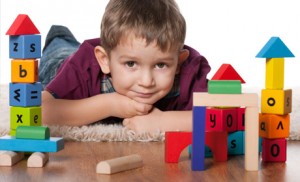Wait! Don’t panic when your child plays doctor with her stuffed animals. It’s a normal and healthy rite of passage.
Leslie Kramer’s 4-year-old daughter, Georgia, enjoys playing with dolls. Scratch that. She is obsessed by it. Her two favorites, Cha Cha and Miss Piddy, go with her everywhere – on errands in the car, out to eat with the family, even to Sunday School – always meticulously dressed in outfits hand sewn by her mom.
So when the Franklin mom found Cha Cha and Miss Piddy undressed and carelessly abandoned in Georgia’s room, she wondered what was up. As soon as the opportunity presented itself, Leslie listened stealthily through a teeny opening in Georgia’s door. The little girl was teaching her dolls how to use the potty.
“They were afraid of it,” says Leslie. “Georgia was making them learn how to use it, which is funny, because she’s had a few accidents lately,” she adds. But Georgia’s no dummy. By pretending to teach her dolls, she can actually work through her tangled feelings about potty training and even relearn what she already knows.
“Seeing that she was trying to work it out made me feel really proud of her,” says Leslie.
Make Believe: It’s Normal
Pretending, or make-believe, is part of every child’s healthy development. It helps children learn what’s going on in the world around them and allows them to connect with and project their inner creativity. Just watch a little boy playing on the floor with his Matchbox cars. Yes, he smashes them together and delves into daredevil feats, but he’s also imagining scenarios to match the ideas he has about power in his head.
If you examine the idea of pretend play further, you can see that kids engaged in it are actually deconstructing some rather complicated life themes: friends and enemies, love and war, sickness and health … and yes, even the more mundane aspects of life like potty training.
Child development experts agree that pretending is important stuff for children – and that parents should give their kids plenty of time for it on a daily basis.
“By playing imaginary games, children get to think out-of-the-box and learn that a particular toy or object can be used for many functions,” says Sohee Park, a professor of psychology at Vanderbilt University in Nashville. Among Park’s studies is the biological foundation of creativity.
“Such mental flexibility can be enormously helpful in real life,” Park says. “Imaginary games can help children realize or apply what they already know into novel, complex, real-life situations, and each time they play with their friends, they can come up with new ideas and unique solutions while learning how to interact with other people,” she adds.
Where Has Pretend Play Gone?
While pretend play is every young child’s rite of passage, many parents and child development experts are voicing concerns that electronic games are taking away from it. Childhood, they lament, is far different today than it once was.
“I use to spend hours with my friends playing house,” says Sherrie Blackburn, a Murfreesboro mom of two children, ages 4 and 7. “We would play outside using pinecones and rocks to create our room boundaries and make furniture from things we found in the yard or garage. I kind of feel like I force my kids to play sometimes. And of course, it’s so easy to just plop them in front of the TV.”
At first, pretend play gave way to TV. Now, it’s losing out to game systems, too. Even 3-year-old children can be seen with Nintendo DS systems in their hands while out and about with their parents.
“I am concerned because when children are glued to TV sets or computer games for hours at a time, they are not engaged in other activities that are more important,” says Park. “Computers can be good learning aids, but they cannot replace family, teachers and friends who are children’s best teachers. Social interactions may seem like non-cognitive, non-intellectual activities, but they require a great deal of brain activity,” she says.
But does that mean that parents should unplug the electronic toys their children love? And, do children who spend more time in activities requiring imagination have the upper hand when it comes to intelligence?
While the direct correlation between intelligence and imagination has not been proven, at least one recent study makes some headway. Professor Sandra Russ at Cleveland’s Case Western Reserve University found that first and second graders who show high levels and quality of fantasy and imagination in their play score higher on tests measuring their ability to accommodate stressful situations. More imaginative kids are better equipped to deal with forgetting their lunch or being picked on by a bully.
“Because children come up with different ideas in fantasy play – taking on different roles and voices – it’s practice for divergent thinking and problem solving,” says Russ. Divergent thinking means that imaginative children can generate different ideas about a topic, and this ability to generate alternatives allows children to become better problem solvers.
So what happens to the kids who are dependent on electronic fun? Studies from the Journal of Educational Research have shown that excessive TV watching, at least, is detrimental to creativity and academic success.
“Imaginary play is not going to translate to an intelligence increase in 50 points or whatever,” says Park. “However, expansive imagination will be evident in essays or stories that children write, in their paintings, in the way they approach novel situations and perhaps even in the way they play their video games,” she says. “It is important to remember that most revolutionary advances and progress in science required an expansive imagination. Talking about computer games, the people who came up with those ideas are obviously innovative and imaginative!” she adds.
Nurturing Creative Minds
“My mom lets us make forts in our family room!” exclaims 8-year-old Reilly Reynolds of Brentwood. “She gives us sheets and blankets and lets us pull the cushions off the couch. But she won’t let us take any food in there. I think she should,” he adds.
Can it be that your child’s aptitude for imaginary play actually comes down to your aptitude for it?
“I’ll admit that it’s easy to just let my son play away on the computer. It’s helpful if he can just sit still while I get dinner made,” says Reilly’s mom, Sandy. “But I know that he shouldn’t be sitting there all the time – he would if I’d let him,” she adds.
There are easy ways for parents to build imagination and creative play for their children if it appears to be lacking. Flexibility in the home is a great place to start. Meticulous parents have to loosen up the reigns a bit to make room for their children’s fun sans electronics. It may be a challenge initially, but with perseverance, you can become the catalyst for change.
Child psychologist Roberta Golinkoff, co-author of Einstein Never Used Flashcards (Rodale Books; $14.95) says parents should look for activities that are “10 percent toy and 90 percent child.” Golinkoff’s co-author, Kathy Hirsh-Pasek, says, “Electronic educational toys boast brain development and that they are going to give your child a head start. But developmental psychologists know that it doesn’t really work this way. Toy manufacturers are playing on parents’ fears that our children will be left behind in the global marketplace.”
Golinkoff concurs, “Kids are like empty vessels waiting to be filled. If they play in a way that allows them to be explorers, they are more likely to learn important lessons about how to master their world.”
Susan Swindell Day is editorial director for this magazine. She has four children.
10 ways to Encourage Your Child’s Imagination
- Establish a dress-up corner in your home with old clothing and personal accessories (pocketbooks, hats, costume jewelry, etc.).
- Keep crayons, watercolors, clay, construction paper and glue in an accessible place.
- Put on a play with your child based on a story she knows, or even better, based on a story that she makes up.
- Provide blankets and sheets for building tents and other imaginative games.
- Encourage your child to build with construction toys and other items that give her props to create her world.
- Make up songs and stories together. Take turns. You say one line or sentence, your child creates the next.
- Spend as much time as possible in nature, preferably in wild places.
- If your child invites you, get involved in her fantasy. Get on that imaginary boat, be a second-in-command on that spaceship, be the Daddy in the pretend family. Be sure to let your child take the lead.
- In the toy corner, have fabric, seashells, stones, sticks, boards, pine cones, string, rope and other open-ended materials.
- If you see your child daydreaming, smile and don’t interrupt.
source: thewholechild.org





